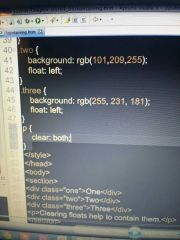![]()
![]()
![]()
Use LEFT and RIGHT arrow keys to navigate between flashcards;
Use UP and DOWN arrow keys to flip the card;
H to show hint;
A reads text to speech;
14 Cards in this Set
- Front
- Back
- 3rd side (hint)
|
<DIV>
|
block level element. A block-level element starts on a new line and stretches out to the left and right as far as it can
|
|
|
|
<span>
|
Standard inline element. In line element can wrap some text inside a paragraph without disrupting the flow of the paragraph.
|
|
|
|
CSS background property
|
Used as a shorthand method to specify one or more background properties. color, image, repeat, attachment, position
|
|
|
|
CSS border property
|
Used to specify one or more of the three border values. With, style, and color
|
|
|
|
Static positioning
|
Static positioned element is always position according to the normal flow of the page static positioned elements are not affected by the top, bottom, left, and right properties
|
|
|
|
Fixed positioning
|
Element with a fixed position is positioned relative to the border window, and will not move even if the window is scrolled
|
|
|
|
Relative position
|
Position and relative to its normal position
|
|
|
|
Selectors can be grouped
|
ul, li, p {font-size: 16px;
color: blue; } |
|
|
|
Left float property
|
Element floats to the far left edge of its parent container. The container is most likely a body tag. It says nothing can float to my left.
|
|
|
|
Right float property
|
Element floats to the far right edge of its parent container. The container is most likely a body tag. It says nothing can float to my right.
|
|
|
|
Container collapse
|
This is when you float an element and the element leaves the flow of the page. so if you left float, or right float the body tag that was containing that element will no longer contain that element.
|
|
|
|
clear property
|
The clear property has five possible values: left, right, both, inherent or none. By clearing an element, you can ensure the element does not appear to the left or the right of any floated element. This has the result of turning off and restoring normal document flow to the remaining elements.
|
|
|
|
How do you help to solve container collapse?
|
In order to prevent the layout of the page from messing up when you float elements, you can add a paragraph <p> below the <div's> that you are floating. Then go back to the CSS for the <p> and add in : clear:both
2nd option: you can go to the CSS selector that contains your elements and add the overflow property. overflow: scroll, auto, or hidden. overflow:hidden. will hide scroll bars and keep content contained. |

|
|
|
Clear fix technique for collapsing elements.
|
used to prevent parent collapse.
Add a css class to the parent element. add to styles and apply be quick fix class to any element you need to contain the floats inside of it. ex: <section class="clearfix"> CSS: <style> . clearfix:before, .clearfix:after{ content:""; display:table;} .clear fix:after{ clear:both } </style> <style> /*For IE <8 (trigger hasLayout)*/ .clear fix { zoom:1;} </style> <![end if]--> This method adds a empty string of content after your float elements to keep the parent from collapsing. |
|

